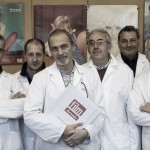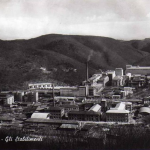Ferrania – Rising Like a Phoenix

By Ron Merk
Ferrania’s film stocks have been used in many of the great Italian films and also by other European filmmakers for decades. But after 3M took over the company, lower demand for film stocks and other economic factors, shut down Ferrania for years. The factories sat empty, with all the equipment that had formerly produced some of the finest film stocks available. What could have happened to this complex is a scary scenario. But two forward-looking Italians decided that Ferrania was worth saving, and that it could also be a solid business proposition.
I recently had the opportunity to interview Dave Bias who’s the U.S. representative of the newly-constituted Ferrania.
David, how did you get involved with the “new Ferrania,” when and why?
I became involved with FILM Ferrania in October 2013 when one of the founders, Nicola Baldini, answered my email. I had sent him a long “manifesto” containing my thoughts about what was wrong with the film industry in general, and what I felt needed to change for a new company to be viable for the long term in this new market. Nicola replied by sending HIS manifesto on the same topics, which read like an Italian version of my own. It was a meeting of minds…
What will your role be in the USA going forward as Ferrania begins to manufacture still and movie film stocks?
For now, I am simply in place to guide the new US subsidiary through the early startup stages. Next year, I will be in charge of launching sales operations. Eventually, I will move into a creative role, which is my natural environment.
Will Ferrania move into 35mm professional motion picture camera films, intermediate stocks, and preservation stocks? Does Fuji’s discontinuation of many stocks motivate a move by Ferrania to create such stocks?
The short answer to both questions is yes. Fuji’s exit from the cinema film business certainly opens a gap that we wish to step into, to the degree that we are able. However, it must be noted that we will have a very restricted capacity until we get all of the machinery we’ve purchased integrated into the factory building – including of course the machines that we are buying in November using the proceeds from our Kickstarter campaign.
As Kodak’s production lines slow down or stop, do you see Ferrania picking up the business that Kodak can no longer support because of its complicated and bulky production processes?
Kodak is hard to figure out. If they are able to make an arrangement with the major studios to continue Vision 3 production – then they will remain the industry standard for several more years. Our hope is that they remain in the business at least long enough to give us time to get our own operations up to speed.
Does the slowing down of film use by the film business and by film users in general concern you? If not, why not?
We are not concerned by the reduced market for film products. In our research, we have discovered that this new reduced market is very stable, and still quite impressive in size. Some folks even report slight growth over the past few years.
We understand very clearly that film is not “dead” – but the old way of making film is dying and it’s taking film down with it. This is the very reason for our decision to create a new, right-sized manufacturing base built from pieces of the old Ferrania factory.
Do you see a return to film in any substantial way, and is this in some way related to the availability of reliable film stocks?
We are modern and rational people. We do not foresee a mass-market return to film in any significant way. But you are correct that the reduced availability of stocks has only fed the “film is dead” meme and created a self-fulfilling prophecy.
We understand that simply by changing the dialog from “film is dead” to “film is alive”, we can bring many people back to film who had previously given it up. We can also appeal to the vast number of young people who grew up “digital” and for whom analog photography is a new and novel experience. We know that there are many companies around the world that wish to purchase materials and even finished products from us for their own purposes. And as we have seen recently, there are still a number of big-name film directors that prefer film and will not walk away from it without a fight.
This combination of elements is more than enough to sustain our plans.
Will Ferrania produce any reversal print stocks to make dupes from original reversal?
We aim to set up our operations to be highly flexible and able to respond to the market quickly. Beyond that, it’s simply too soon to answer this question with any confidence.
Who are the main organizers of the new Ferrania, and what are their backgrounds?
The co-founders are Nicola Baldini and Marco Pagni who have been friends since childhood.
Nicola used to be a software engineer, but he fell in love film filmmaking several years ago. He has directed a number of films and produced several more. Marco has worked in film processing labs since he was a teenager. He owns a lab in Florence, and is a globally recognized film restorationist.
In addition to them, we have six scientists and technicians from the former Ferrania company who were trained during the 3M era and have direct experience producing film in the very same building that we occupy today. I must admit that I have not yet had the pleasure to interact with any of them directly – but we have put together a nice introduction on our website.
Here in the US, we have me and Anne Bowerman, who joined us earlier this month. We are analog film fans who had the good fortune to start up US operations for The Impossible Project back in 2008. Anne is the marketing and social media genius who builds community (and my girlfriend of 7 years). She has a knack for putting the heart and soul into any business that she works for. I’m the over-ambitious crash-test dummy who is willing to do whatever needs to be done on any given day to spread the word about the things I love. Currently, that involves answering interview requests so that Nicola and the rest of the team can put their heads down and make some film. I’m also the de facto webmaster, and as I mentioned previously, I will be starting up sales operations next year.
Why did these organizers decide to resurrect Ferrania and go back into film raw stock manufacturing?
The full story of this has recently been published on our website. The short answer is simply that a business opportunity presented itself and they were uniquely willing and able to see the potential and get it moving in the right direction.
Why do you think that the continued manufacture of film stocks, both for stills and motion pictures is important? To the business, to the arts and to long-term preservation?
Making film is important because choice is important. This is arguably the best time in history to make images because we have the choice of analog or digital capture. For us at FILM Ferrania, it seems almost criminal that our choices would be narrowed simply because a couple of giant multi-national companies couldn’t figure out how to adapt to the changing market. As such, we aim to step in to keep the choice of film alive for future generations.
Do you see the Ferrania brand becoming recognized and growing in reputation? Why?
Ferrania has never had strong brand-recognition outside of Italy, and so we really have nowhere to go but up.












